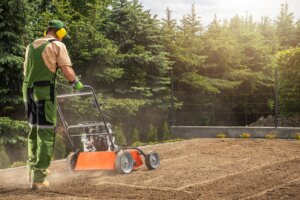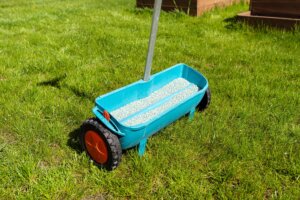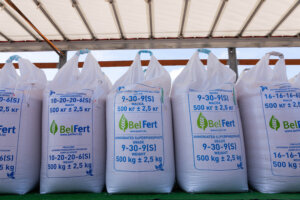Short Answer:
To reseed your lawn in fall, mow the existing grass short, remove debris, and loosen the top layer of soil. Spread cool-season grass seed evenly using a broadcast spreader, then lightly rake or roll for good seed-to-soil contact.
Keep the area consistently moist with light daily watering until the seedlings reach mowing height, then transition to deeper, less frequent watering.
Fall’s warm soil and cool air give seeds the best chance to germinate quickly, outcompete weeds, and build strong roots before winter.
Quick Fall Reseeding Snapshot
| Step | Key Actions | Why It Matters |
|---|---|---|
| 1. Mow Lawn Short | Cut to 1½–2 inches, bag grass clippings | Improves seed-to-soil contact |
| 2. Prepare Soil | Rake, aerate, or use slit seeder | Loosens soil and reduces compaction |
| 3. Choose Seed | Select cool season grass seed blend | Matches growing conditions for PA lawns |
| 4. Spread Evenly | Use broadcast spreader in two directions | Ensures uniform coverage |
| 5. Water Correctly | Light, frequent watering at first, then deep | Supports germination and strong roots |
| 6. Fertilize | Starter fertilizer 6 weeks after germination | Boosts growth before winter |
Why Fall Is the Best Time to Overseed Your Lawn
Fall offers the perfect balance of warm soil temperatures and cooler air, which helps new grass seed germinate quickly and grow strong before winter. Fewer weeds are competing for resources, and the longer growth period allows roots to establish deeply.
In Pennsylvania, the University of Minnesota recommends reseeding between mid-August and mid-September for the best results with cool-season grasses like Kentucky bluegrass, perennial ryegrass, and fine fescue.
Don’t leave it too late — reseeding too close to the first hard frost can prevent new grass seedlings from establishing properly.
Preparing the Lawn Short Before Seeding

Getting your lawn ready for new seeds makes a big difference in how well they grow. Start by mowing short — about 1½–2 inches — and bagging grass clippings so they don’t block the seed. Remove debris, dead patches, and excess thatch. For thin lawns or compacted areas, mechanical preparation will help the seed take hold.
Best prep tools and methods:
- Slit seeder for direct seed placement into grooves
- Core aerator to improve air, water, and nutrient movement (20–40 holes per square foot as per Iowa State University )
- Rake to loosen the top layer of soil for better seed-to-soil contact
Choosing the Right Grass Seed Types
The right seed mix depends on your lawn’s sun exposure, traffic levels, and existing grass. In Pennsylvania, cool-season grass seed blends dominate for year-round performance, especially if you want winter color and fewer weeds.
Popular cool-season options:
- Kentucky bluegrass for fine texture and deep green lawn color
- Perennial ryegrass for fast germination and quick patch repair
- Fine fescue for shade tolerance and low maintenance
Warm-season grass is generally overseeded only in southern climates, but knowing the difference helps if you have a mixed lawn.
Cool Season vs. Warm Season Grass for Reseeding
| Feature | Cool Season Grass | Warm Season Grass |
|---|---|---|
| Best Reseeding Time | Fall (mid-August–mid-September) | Late Spring to Early Summer |
| Common Types | Kentucky bluegrass, perennial ryegrass, fine fescue | Bermudagrass, zoysiagrass, centipedegrass |
| Germination Speed | Bluegrass seed slower, ryegrass faster | Typically slower than ryegrass but varies |
| Winter Performance | Stays green in winter months | Goes dormant and brown in cold weather |
| Disease Resistance | Strong when properly fertilized in fall | Varies; may need more summer care |
| Ideal for Pennsylvania? | Yes — thrives in local turf conditions | No — prefers southern summer months |
How Much Seed to Apply

Overseeding rates vary by grass type, so follow label directions and adjust for bare patches or lawn renovation.
Recommended overseeding rates:
- Kentucky bluegrass: ~2 lbs per 1,000 sq. ft.
- Tall fescue: 3–4 lbs per 1,000 sq. ft.
- Fine fescue/perennial ryegrass: 4–6 lbs per 1,000 sq. ft.
Using a Broadcast Spreader for Even Coverage
Even seed distribution is key to a consistent green lawn. Set the broadcast spreader according to label directions. Apply half the seed north–south and the other half east–west, then lightly rake or roll the area so the new seeds have firm soil contact.
Watering and Fertilizer After Seeding
Watering is one of the most important steps after overseeding. Keep the soil surface moist with light, frequent watering until germination occurs. As the grass reaches mowing height, water more deeply but less often to encourage strong root growth. Six weeks after germination, apply a starter fertilizer to improve growing conditions — the University of Nebraska recommends 1 lb of nitrogen per 1,000 sq. ft.
Repairing Bare Patches During Lawn Renovation
If you’re reseeding as part of a full lawn renovation, pay special attention to bare patches. Loosen the soil, apply the same seed mix, and cover lightly with straw mulch to hold in moisture and block weeds. Overseeding warm-season grass is common in southern areas but not in Pennsylvania.
The Role of a Green Team in Reseeding
For lawns with thin areas, poor growing conditions, or a mix of grass seed types, a professional green team can deliver better results. Terra Lawn Care Specialists uses soil temperature readings, seed quality checks, and proven overseeding methods to ensure lasting improvements.
Maintaining a Healthy Lawn After Reseeding
Once the new seedlings are established, shift your care routine to maintain their health:
- Mow at the right height for your grass type
- Fertilize based on soil test results
- Water deeply but less frequently to promote root depth
- Aerate annually to relieve compaction and improve growing conditions
With consistent care, your lawn will stay thick, resist summer stress, keep its winter color, and have fewer weeds year-round.
Need Help With Your Lawn This Fall?
If you’d rather skip the guesswork, Terra Lawn Care Specialists can handle the entire process — from choosing the right grass seed mix to preparing the soil and ensuring perfect seed-to-soil contact. Our licensed technicians know Pennsylvania lawns inside and out, and we treat your property like it’s our own. Contact us today to schedule your lawn renovation and enjoy a greener, healthier yard all year long.
For even more ways to keep your yard in top shape, check out our lawn mowing tips to pair with your reseeding plan.



